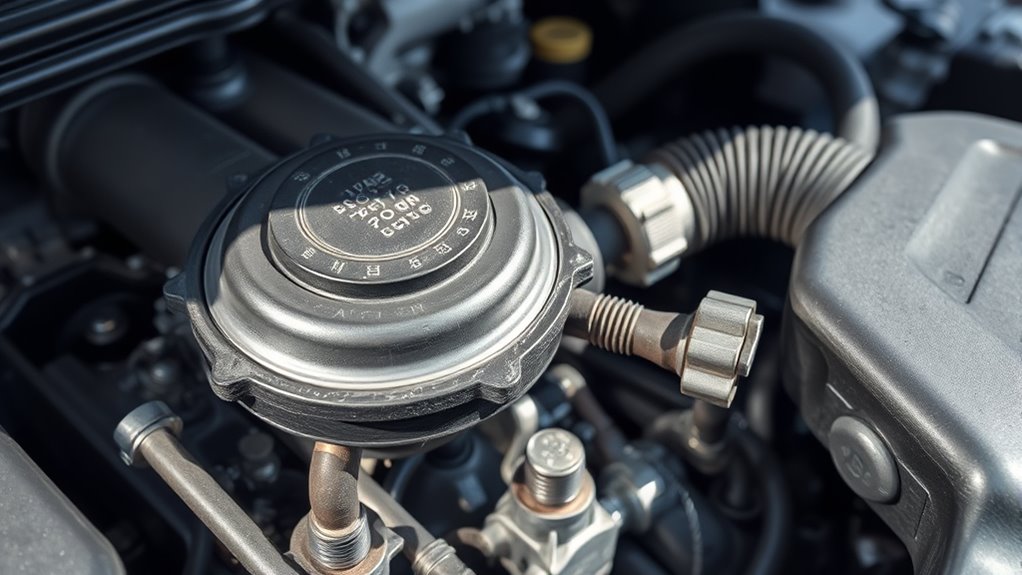If you’re experiencing coolant loss without visible leaks, start by inspecting the radiator, hoses, and clamps for tiny cracks or pinholes that may cause slow seepage. Check the overflow reservoir and connected hoses for cracks or leaks, and look for signs of internal leaks like sweet smells or coolant in the cabin. Don’t forget to examine the water pump and internal gaskets for subtle signs of failure. Continuing guarantees you understand how hidden leaks may be impacting your engine.
Key Takeaways
- Inspect radiator hoses and connections for tiny cracks, pinholes, or loose clamps causing slow coolant seepage.
- Check the overflow reservoir and its hoses for cracks, leaks, or internal damage that may lead to coolant loss.
- Examine the heater core lines and interior components for signs of internal leaks, such as sweet smells or coolant in the cabin.
- Look for subtle water pump leaks or corrosion that could cause coolant loss without external puddles.
- Consider internal engine issues like head gasket failure, which can cause coolant loss without visible external leaks.

If your vehicle is losing coolant but you don’t see any visible leaks, it can be confusing and concerning. You might be wondering where the coolant is going since there are no puddles on your driveway or obvious drips under the engine. The good news is that coolant can escape in subtle ways that don’t leave an immediate trail, so it’s important to know where to look and what signs to watch for.
Start by inspecting the radiator and hoses closely. Even if they don’t appear cracked or broken, small leaks can occur at connection points or along the seams that aren’t immediately obvious. Sometimes, a tiny pinhole in a hose or a loose clamp can let coolant seep out slowly, evaporating before it hits the ground. Also, check the radiator cap; a faulty or worn cap can cause pressure to escape, leading to coolant loss without a visible leak. If the cap isn’t sealing properly, coolant can blow off into the overflow tank or evaporate, making it seem like the system is losing fluid without any external signs.
Inspect radiator connections and cap for tiny leaks or pressure escapes causing coolant loss unnoticed.
Next, examine the overflow reservoir and the hoses connected to it. Cracks or loose fittings here can leak coolant internally or externally, especially during temperature changes when pressure builds up. If the reservoir looks discolored or has deposits around its base, it could be a sign that coolant has been escaping and evaporating. Don’t forget to check the heater core and its lines—these are often hidden behind the dashboard but are common sources of internal leaks. When these leak, coolant can enter the cabin or cause a sweet smell without any visible external leaks under the vehicle. Additionally, understanding the role of the water pump**** in circulating coolant can help identify less obvious failure points, as leaks or weeps here may not produce obvious puddles but still cause fluid loss.
Another area to scrutinize is the water pump. Although leaks here are usually noticeable, sometimes a small weep or a faulty seal can allow coolant to escape internally or in a way that doesn’t produce a large puddle. Look for signs of corrosion or residue around the pump, which can indicate a slow leak. Also, keep an eye on your temperature gauge; frequent overheating or fluctuating readings can point to coolant loss through internal leaks or inefficient circulation caused by a failing pump.
Finally, consider internal engine issues such as head gasket failure. When the gasket fails, coolant can leak into the engine cylinders or oil passages, leading to coolant loss without external leaks. You might notice milky oil on the dipstick or white exhaust smoke, which are telltale signs. These problems are less obvious but equally serious, requiring prompt diagnosis and repair.
Frequently Asked Questions
Can a Blown Head Gasket Cause Coolant Loss Without Leaks?
Yes, a blown head gasket can cause coolant loss without visible leaks. When the gasket fails, coolant can seep into the engine cylinders or oil passages, leading to internal consumption.
You might notice white smoke from the exhaust, milky oil, or overheating, even if you don’t see any external leaks. It’s crucial to check for these signs and have a mechanic diagnose the issue promptly to prevent engine damage.
How Long Does It Take for Coolant Levels to Drop Noticeably?
Coolant levels can drop noticeably in as little as a few days if there’s a significant leak or internal issue.
On average, you might see a decline within a week, especially if you’re driving regularly. Keep an eye on your coolant gauge or check the reservoir weekly.
If you notice a rapid decrease, it’s a sign to inspect for leaks or engine problems, like a blown head gasket, that could be causing the loss.
Is It Safe to Drive With Unknown Coolant Loss?
No, it’s not safe to drive with unknown coolant loss. If you notice your coolant levels dropping or overheating signs, stop driving immediately.
Continuing to drive can cause engine damage or overheating, leading to costly repairs. Have your cooling system checked promptly by a mechanic to identify the leak and prevent further issues.
Always monitor your coolant levels regularly to avoid dangerous situations on the road.
Can a Faulty Radiator Cap Cause Coolant Loss Without Visible Leaks?
A faulty radiator cap can definitely cause coolant loss without visible leaks. Think of it as a safety valve that maintains pressure; if it malfunctions, coolant can escape as steam or vapor, leaving your engine underperforming without obvious drips.
You might notice your temperature gauge rising or the smell of coolant. Check the cap for cracks or wear, and replace it if necessary to prevent hidden coolant loss.
What Are the Signs of Internal Coolant Leaks?
You might notice your engine overheats frequently or runs hotter than usual, which are signs of internal coolant leaks. You could also see white smoke from the exhaust or a sweet smell from the tailpipe, indicating coolant burning inside the engine.
Keep an eye on your coolant level; if it drops without visible leaks, internal leaks are likely. Also, check for milky oil, which signals coolant mixing with oil.
Conclusion
Even when you don’t see a leak, coolant loss can still leave you stranded. It’s frustrating to lose coolant silently, risking engine damage without a visible sign. But with careful inspection—checking hoses, radiator cap, and internal components—you can catch the hidden culprit. Don’t let uncertainty stall your day; stay vigilant. Sometimes, the quietest problems cause the loudest damage. Trust your instincts and look deeper—your engine’s health depends on it.









